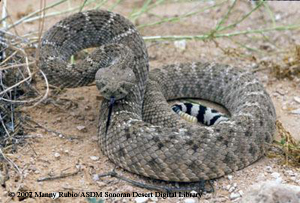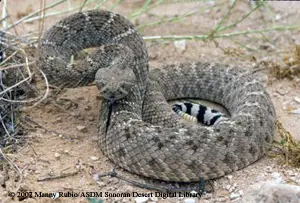The Diamondback Rattlesnake is a fascinating creature that has intrigued humans for centuries. With its distinctive rattle and venomous bite, this snake has earned a reputation as both a feared predator and a symbol of the American Southwest.
Despite its iconic status, however, there is growing concern about the future of the Diamondback Rattlesnake. Many experts believe that habitat destruction and human encroachment are putting this species at risk, and there are calls for greater protections to ensure its survival. In this article, we will explore the question of whether the Diamondback Rattlesnake is truly endangered, and what can be done to preserve this remarkable animal for future generations.
The Diamondback Rattlesnake is not currently listed as endangered, but it is a species of concern in some states due to habitat loss and other threats. Conservation efforts are underway to protect the species and its habitat.

Is the Diamondback Rattlesnake Endangered?
The Diamondback Rattlesnake is an iconic species of North America. It is known for its venomous bite and distinctive rattle. However, in recent years, there has been concern about the population of these snakes. Many people are asking if the Diamondback Rattlesnake is endangered. In this article, we will explore the current status of the species and the reasons why it may or may not be endangered.
Current Population of Diamondback Rattlesnakes
The Diamondback Rattlesnake is found in many parts of North America, from Mexico to the United States. However, the exact population of these snakes is difficult to determine. This is because they are solitary animals that are often hidden in remote areas. Nevertheless, studies estimate that there are hundreds of thousands of Diamondback Rattlesnakes in the wild. This means that the species is not currently endangered.
However, there are some areas where the population of Diamondback Rattlesnakes is declining. This is due to habitat destruction and human encroachment. When their habitat is destroyed, Diamondback Rattlesnakes are forced to seek food and shelter in areas where they are more likely to encounter humans. This can lead to conflicts between humans and snakes, which often result in the death of the snake.
Reasons Why Diamondback Rattlesnakes May be Endangered
While the Diamondback Rattlesnake is not currently endangered, there are several reasons why it may become endangered in the future. One of the main reasons is habitat destruction. As more and more land is developed for human use, the habitat of the Diamondback Rattlesnake is shrinking. This makes it more difficult for the species to find food and shelter, and it can lead to a decline in population.
Another reason why Diamondback Rattlesnakes may become endangered is the illegal pet trade. These snakes are often captured and sold as exotic pets. While this may seem harmless, it can have a significant impact on the population of the species. Captured snakes are often taken from the wild, which can lead to a decline in population. Additionally, snakes that are kept in captivity may not be able to reproduce, which can further reduce the population.
Benefits of Diamondback Rattlesnakes
Despite their venomous bite, Diamondback Rattlesnakes play an important role in their ecosystem. They are apex predators, which means that they help control the population of smaller animals. This can help maintain a balance in the ecosystem. Additionally, Diamondback Rattlesnakes are an important food source for other animals, such as birds of prey.
Diamondback Rattlesnakes also have important cultural significance. They are an important part of Native American culture and have been used in traditional medicine for centuries. Additionally, they are a popular animal in zoos and wildlife parks, where they can help educate people about the importance of protecting wildlife.
Diamondback Rattlesnakes vs Humans
While Diamondback Rattlesnakes are an important part of the ecosystem, they can also pose a threat to humans. Their venomous bite can be fatal if left untreated. Additionally, encounters between humans and Diamondback Rattlesnakes can lead to conflicts, which can be dangerous for both parties.
However, it is important to remember that Diamondback Rattlesnakes are not aggressive animals. They will only attack if they feel threatened or cornered. Humans can reduce the risk of encountering a Diamondback Rattlesnake by staying on designated trails and avoiding areas where snakes are known to live.
Conclusion
In conclusion, the Diamondback Rattlesnake is not currently endangered. However, there are several factors that could lead to a decline in population in the future. It is important that we take steps to protect the habitat of these snakes and reduce the impact of human activities. By doing so, we can help ensure that the Diamondback Rattlesnake remains an important part of the North American ecosystem for generations to come.
Frequently Asked Questions
What is the Diamondback Rattlesnake?
The Diamondback Rattlesnake, also known as Crotalus atrox, is a venomous species of pit viper commonly found in the United States, particularly in the southwestern region. It is known for its distinctive rattle, which warns potential predators of its presence.
The Diamondback Rattlesnake is a large snake that can grow up to 7 feet in length. It has a diamond-shaped pattern on its back, which gives it its name. The snake is known for its venom, which can be deadly to humans and other animals.
What is the current status of the Diamondback Rattlesnake?
The Diamondback Rattlesnake is currently not listed as an endangered species. However, its population has been declining in some areas due to habitat loss and fragmentation, as well as human persecution.
Despite not being listed as endangered, the Diamondback Rattlesnake is protected in many states. It is illegal to kill or harm the snake in most places, and it is important to respect its role in the ecosystem.
Why is the Diamondback Rattlesnake important to the ecosystem?
The Diamondback Rattlesnake plays an important role in the ecosystem as a predator and prey species. As a predator, it helps to control populations of rodents and other small animals. As prey, it provides food for other animals such as birds of prey.
The Diamondback Rattlesnake also plays a cultural and historical role in many indigenous communities in the southwestern United States. It is important to protect this species not only for its ecological significance but also for its cultural importance.
What can be done to protect the Diamondback Rattlesnake?
To protect the Diamondback Rattlesnake, it is important to conserve its habitat and reduce human persecution. This can be done through land conservation efforts, education and outreach programs, and enforcing laws that protect the snake.
Individuals can also help protect the Diamondback Rattlesnake by learning to coexist with the species and respecting its role in the ecosystem. This includes avoiding killing or harming the snake, and taking steps to prevent conflicts with the species.
What should I do if I encounter a Diamondback Rattlesnake?
If you encounter a Diamondback Rattlesnake, it is important to give the snake space and respect its presence. Do not attempt to handle or harm the snake, as this can be dangerous for both you and the snake.
If the snake is in a high-traffic area, such as a hiking trail or residential area, it may be necessary to contact a trained professional to safely relocate the snake. Otherwise, it is best to simply give the snake space and allow it to continue on its way.
This Snake Needs SERIOUS Help! – Why Eastern Diamondback Rattlesnakes Are “Endangered”!
In conclusion, the Diamondback Rattlesnake is not currently listed as an endangered species. However, it is important to note that their habitat is continually being threatened by human activities such as urbanization and agriculture. It is crucial that we take measures to protect these beautiful creatures and their environment to ensure they thrive for generations to come.
While the Diamondback Rattlesnake may not be endangered, it is still a vital part of the ecosystem. These snakes help control rodent populations and are preyed upon by other animals, such as hawks and eagles. Without them, the balance of the ecosystem could be negatively impacted.
Finally, it is important to educate ourselves and others about the importance of preserving the habitats of all species, including the Diamondback Rattlesnake. By supporting conservation efforts and making changes in our daily lives to lessen our impact on the environment, we can help ensure that these beautiful creatures continue to thrive and play their vital role in the ecosystem.


